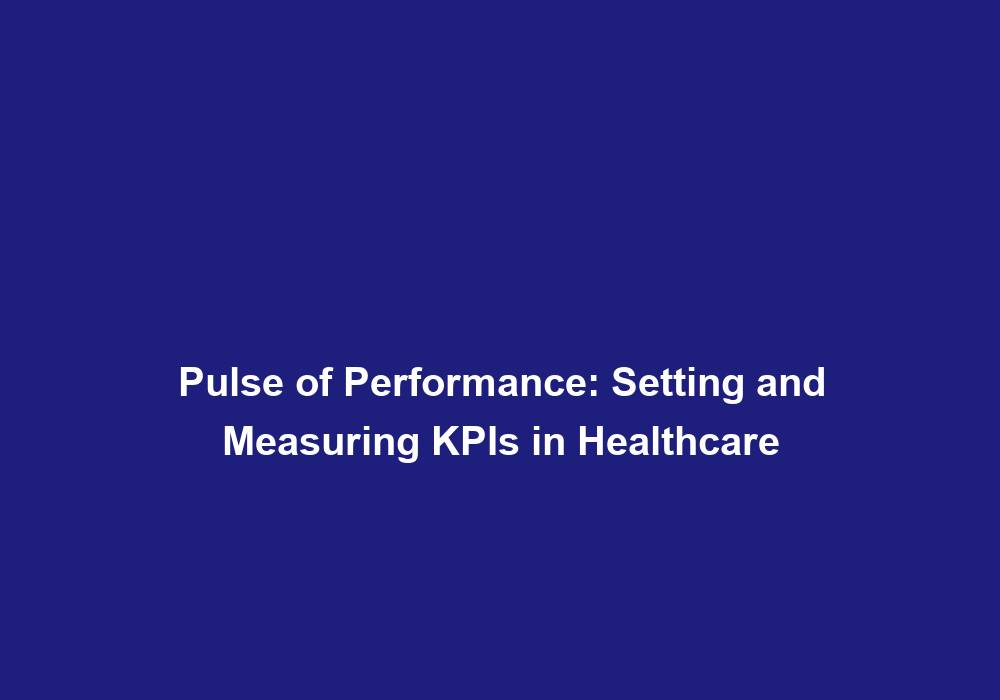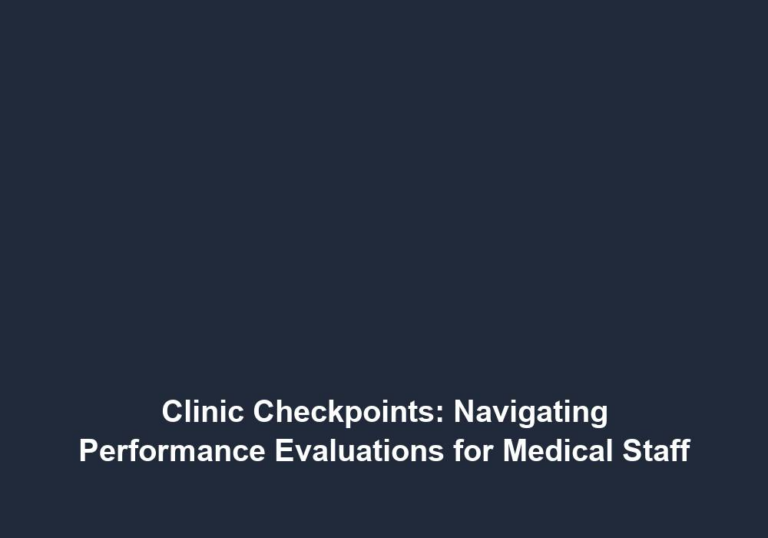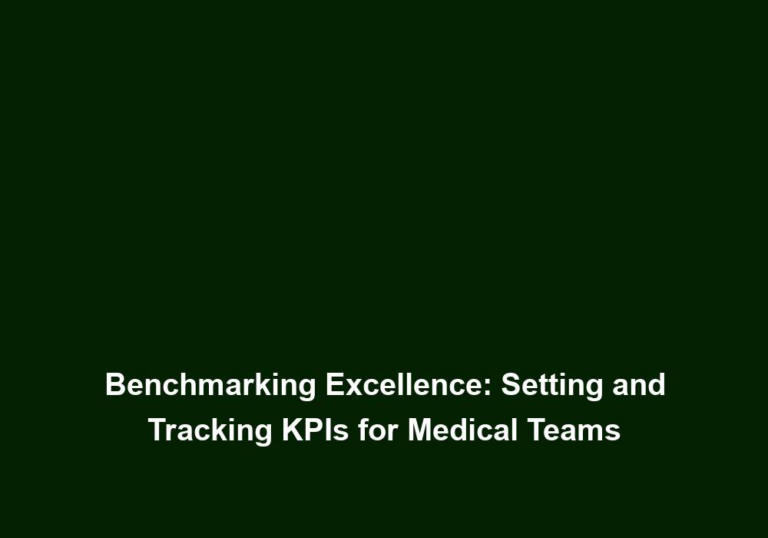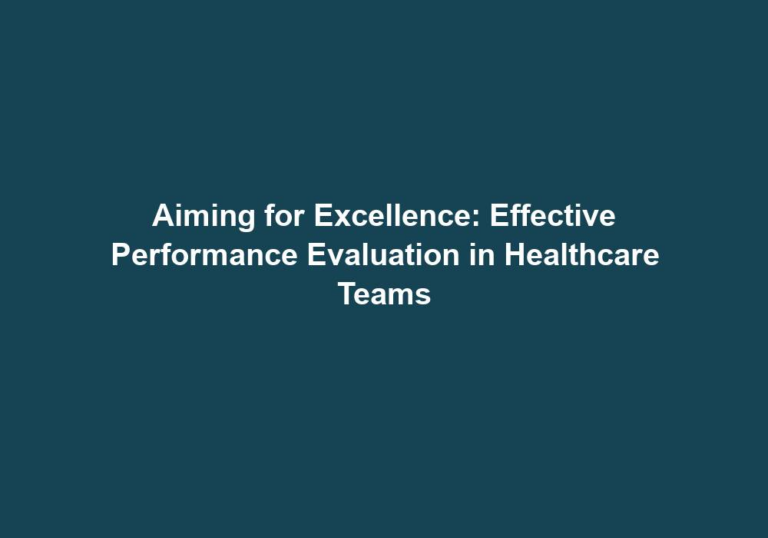Pulse of Performance: Setting and Measuring KPIs in Healthcare
In the fast-paced and ever-evolving world of healthcare, setting and measuring Key Performance Indicators (KPIs) is crucial for organizations to track their progress, identify areas for improvement, and ultimately achieve better patient outcomes. KPIs serve as vital metrics that enable healthcare providers, administrators, and policymakers to monitor and assess performance against established goals and objectives. In this article, we will delve into the importance of KPIs in healthcare, explore the process of setting them, and discuss effective strategies for measuring and evaluating their impact.
Why are KPIs important in healthcare?
- Enhancing patient care: KPIs provide healthcare organizations with a systematic approach to understanding the quality of care they deliver. By measuring specific indicators, such as patient satisfaction rates, wait times, or mortality rates, healthcare providers can identify areas that require improvement to optimize patient care and satisfaction.
-
Patient satisfaction rates: By tracking patient satisfaction rates, healthcare organizations can identify areas where patients may not be fully satisfied with the care they receive. This could include aspects such as communication with healthcare professionals, wait times, or the overall patient experience. By addressing these areas, organizations can enhance patient care and improve overall satisfaction levels.
-
Wait times: Timely access to healthcare services is crucial for patient satisfaction and outcomes. By monitoring and reducing wait times, healthcare organizations can ensure that patients receive the care they need in a timely manner, leading to improved patient experiences and outcomes.
-
Mortality rates: Measuring mortality rates allows healthcare organizations to assess the effectiveness of their interventions and treatments. By identifying areas with higher mortality rates, organizations can implement strategies to improve patient outcomes and reduce mortality rates.
- Operational efficiency: KPIs help healthcare organizations streamline their operations and optimize resource allocation. By monitoring metrics like patient flow, length of stay, or bed occupancy rate, healthcare administrators can identify bottlenecks, reduce inefficiencies, and better allocate resources to enhance the overall efficiency of their facilities.
-
Patient flow: Tracking patient flow enables healthcare organizations to identify areas where patients may experience delays or inefficiencies in their care journey. By streamlining patient flow processes, organizations can improve the overall efficiency of their operations and ensure that patients receive timely and appropriate care.
-
Length of stay: Monitoring the length of stay allows healthcare organizations to assess the efficiency of their care processes. By reducing unnecessary delays and optimizing care delivery, organizations can shorten length of stay, leading to improved patient experiences and increased capacity for new patients.
-
Bed occupancy rate: Tracking bed occupancy rates helps healthcare organizations optimize resource allocation and capacity management. By identifying periods of high demand and adjusting resources accordingly, organizations can ensure that patients have access to the necessary beds and facilities, improving overall operational efficiency.
- Financial management: KPIs play a crucial role in financial management within healthcare organizations. Key metrics like revenue per patient, cost per procedure, or profit margins enable administrators to monitor financial performance, identify areas for cost reduction, and ensure financial sustainability.
-
Revenue per patient: Tracking revenue per patient helps healthcare organizations assess the financial impact of their services. By analyzing revenue per patient, organizations can identify opportunities for revenue growth, optimize pricing strategies, and ensure financial stability.
-
Cost per procedure: Monitoring the cost per procedure allows healthcare organizations to identify areas of inefficiency or excessive costs. By analyzing cost per procedure, organizations can implement cost-saving measures, negotiate better contracts with suppliers, and improve financial performance.
-
Profit margins: Tracking profit margins enables healthcare organizations to assess the financial viability of their operations. By monitoring profit margins, organizations can identify areas of financial strength and weakness, implement strategies to improve profitability, and ensure long-term financial sustainability.
- Quality assurance and regulatory compliance: KPIs assist healthcare organizations in maintaining high standards of quality and meeting regulatory requirements. By tracking indicators related to patient safety, infection rates, or adherence to regulatory guidelines, healthcare providers can proactively address issues, ensure compliance, and continuously improve the quality of care they deliver.
-
Patient safety: Monitoring patient safety indicators allows healthcare organizations to identify potential risks and implement measures to ensure patient safety. By tracking indicators such as medication error rates, falls with injury, or hospital-acquired infection rates, organizations can improve patient safety outcomes and comply with regulatory guidelines.
-
Infection rates: Tracking infection rates helps healthcare organizations identify areas where infection prevention and control measures may need improvement. By implementing strategies to reduce infection rates, organizations can enhance patient safety and comply with regulatory requirements.
-
Adherence to regulatory guidelines: Monitoring adherence to regulatory guidelines ensures that healthcare organizations operate within legal and ethical boundaries. By tracking indicators related to regulatory compliance, organizations can address any gaps or non-compliance issues, thereby maintaining high standards of quality and patient care.
Setting effective KPIs in healthcare
When setting KPIs in healthcare, it is important to ensure they align with the organization’s overall mission, goals, and strategic objectives. Here are some key steps to consider:
1. Identify relevant stakeholders
Engage relevant stakeholders, including clinicians, administrators, and policymakers, to gain a comprehensive understanding of their perspectives and prioritize the KPIs that align with their goals and initiatives. By involving key stakeholders in the process, healthcare organizations can ensure that the selected KPIs reflect the diverse needs and priorities of the organization.
2. Define measurable objectives
Clearly define the objectives that the organization aims to achieve through the chosen KPIs. For instance, if the goal is to improve patient satisfaction, the KPIs could include metrics like patient surveys, complaint resolution time, or patient feedback scores. By establishing measurable objectives, healthcare organizations can track progress and evaluate the effectiveness of their initiatives.
3. Choose meaningful indicators
Select indicators that provide meaningful insights into the organization’s performance and progress towards its goals. These indicators should be specific, measurable, achievable, relevant, and time-bound (SMART). For example, in the context of patient safety, indicators could include medication error rates, falls with injury, or hospital-acquired infection rates. By choosing meaningful indicators, healthcare organizations can focus on areas that have a direct impact on patient outcomes and organizational performance.
4. Establish benchmarks and targets
Set realistic benchmarks and targets for each KPI based on historical data, industry standards, and best practices. These benchmarks will serve as reference points for evaluating performance and progress over time. By establishing benchmarks and targets, healthcare organizations can measure their performance against established standards and identify areas for improvement.
5. Ensure data availability and accuracy
Before finalizing the KPIs, ensure that the necessary data can be collected, analyzed, and reported accurately. Leverage robust data management systems and electronic health records to streamline data collection and ensure data integrity. By ensuring data availability and accuracy, healthcare organizations can rely on reliable information to make informed decisions and evaluate their performance effectively.
6. Communicate and align
Once the KPIs are established, ensure effective communication and alignment across all levels of the organization. Clearly communicate the importance of each KPI, its relevance to individual roles and responsibilities, and how it contributes to the organization’s overall success. By fostering a culture of transparency and alignment, healthcare organizations can ensure that everyone understands the significance of the KPIs and actively works towards achieving the established goals.
Measuring and evaluating KPIs in healthcare
Effective measurement and evaluation of KPIs are essential to track progress, identify trends, and make data-driven decisions. Here are some strategies to consider:
1. Regular data collection and analysis
Implement systems and processes to collect relevant data regularly. Leverage technology solutions to automate data collection and analysis, reducing manual effort and minimizing the risk of errors. By implementing regular data collection and analysis, healthcare organizations can ensure that they have up-to-date and accurate information to evaluate their performance.
2. Visualize data through dashboards
Leverage data visualization tools and dashboards to present KPIs in a visually appealing and easily understandable format. This enables stakeholders to quickly interpret trends, identify patterns, and make informed decisions. By visualizing data through dashboards, healthcare organizations can facilitate data-driven discussions and enhance the accessibility and usability of KPI information.
3. Conduct regular performance reviews
Schedule regular performance reviews to evaluate progress against established benchmarks and targets. Engage relevant stakeholders in these reviews to facilitate discussions, identify areas for improvement, and develop action plans to address any performance gaps. By conducting regular performance reviews, healthcare organizations can foster a culture of continuous improvement and ensure that KPIs remain relevant and effective.
4. Seek feedback and adapt
Encourage feedback from various stakeholders, including patients, clinicians, and staff, to gain insights into the effectiveness of KPIs. Adapt the KPIs as necessary to ensure they remain relevant and aligned with the evolving needs of the organization. By seeking feedback and adapting KPIs, healthcare organizations can ensure that they are measuring the right indicators and making necessary adjustments to drive improvement.
5. Continuously improve and innovate
Use KPIs as a source of inspiration for continuous improvement and innovation. Analyze the data collected to identify best practices, areas of success, and opportunities for growth. Share these insights across the organization to foster a culture of learning and improvement. By continuously improving and innovating based on KPI data, healthcare organizations can drive positive change, enhance performance, and achieve better patient outcomes.
In conclusion, setting and measuring KPIs are vital components of effective healthcare management. By establishing meaningful indicators, collecting accurate data, and regularly evaluating performance, healthcare organizations can enhance patient care, improve operational efficiency, ensure financial sustainability, and continuously strive for excellence in the ever-evolving healthcare landscape.






